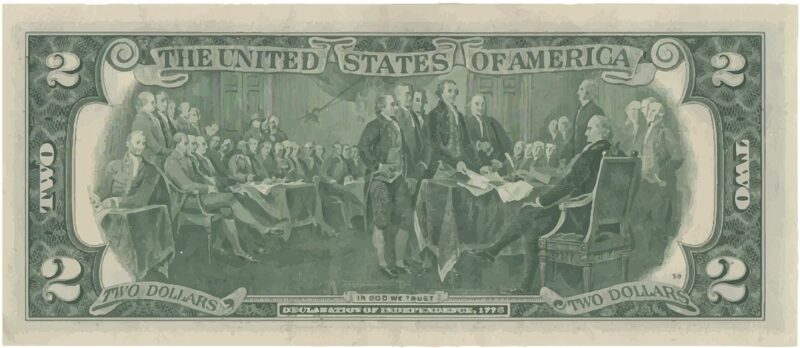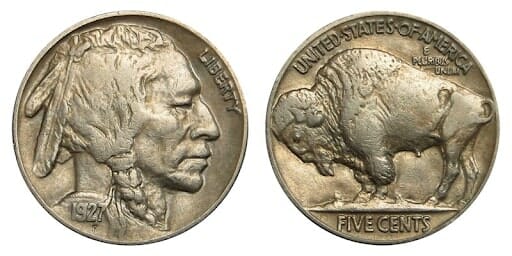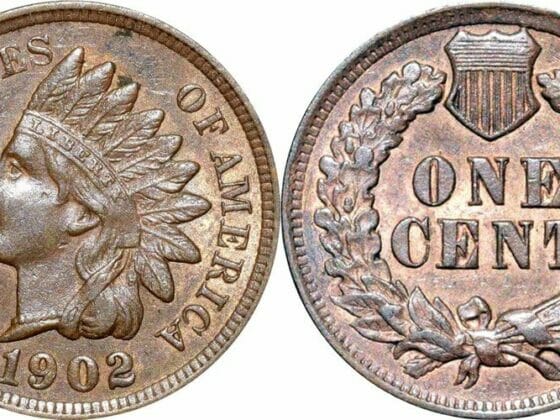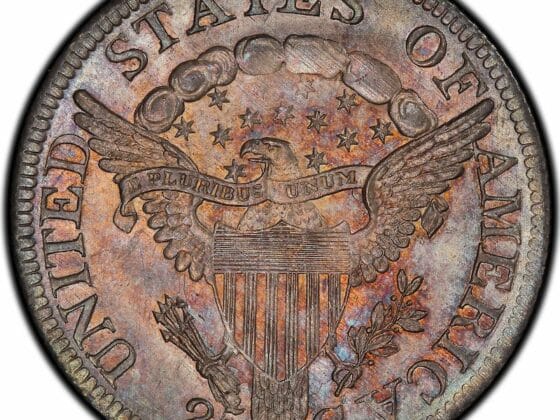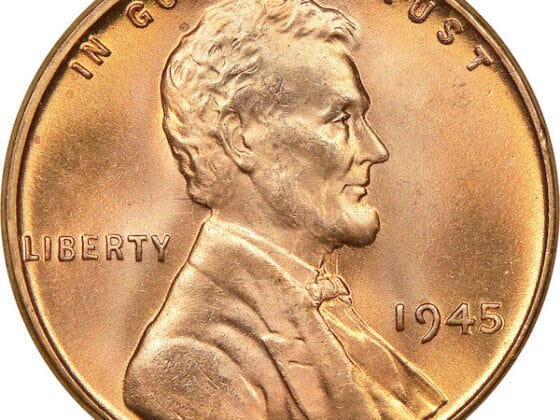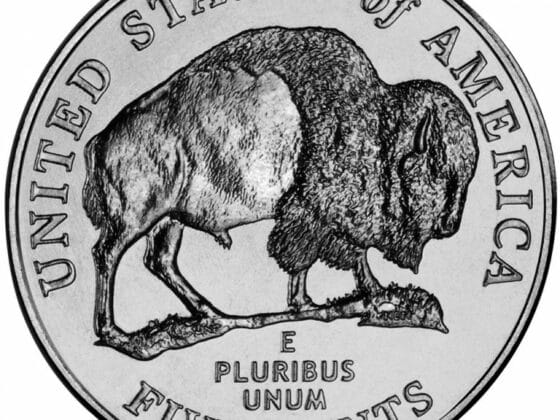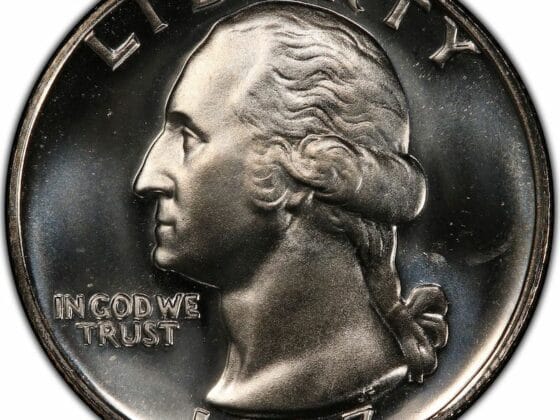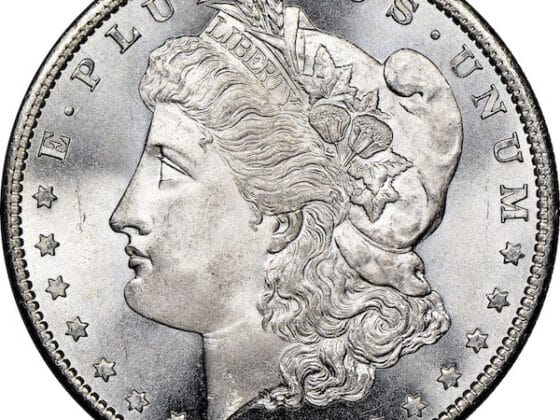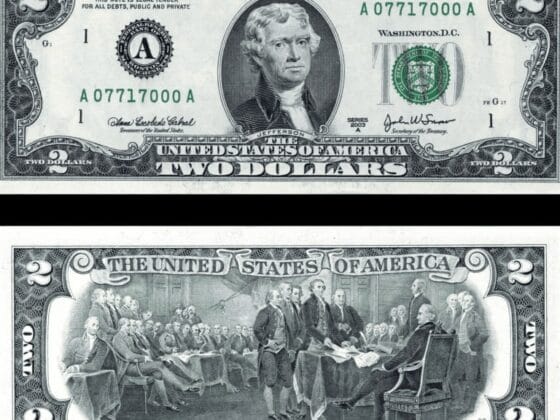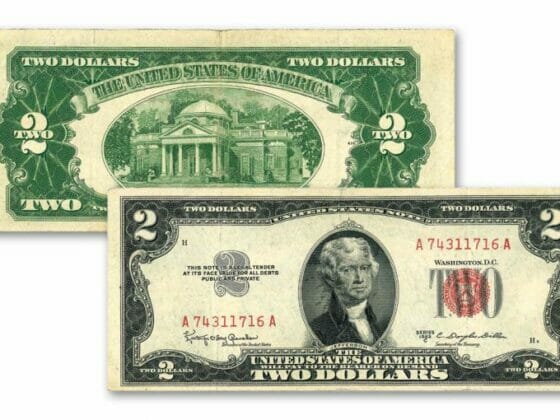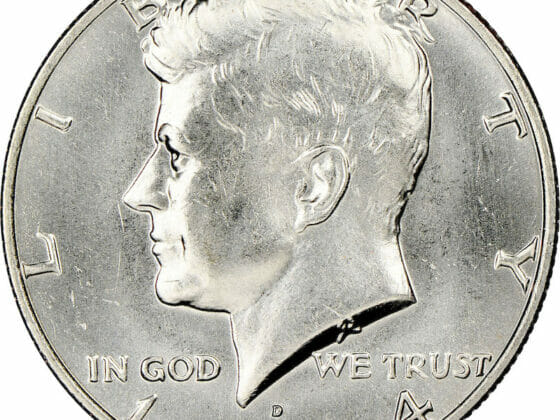The 2 dollar bill is currently a small-sized Federal Reserve note (6.14 inches by 2.61 inches) that has been produced in that size in eight basic series (1928, 1953, 1976, 1995, 2003, 2009, 2013, 2017A) since 1928.
Large-sized $2 bills (7.375 inches by 3.125 inches) were first legislated by Congress in 1862 and further produced in modified designs in 1886, 1890, 1891, 1896, and 1899.
The $2 bill is unique and intriguing because it is seldom seen in financial transactions today (although it is still produced in large quantity) for several reasons:
- The American public has become accustomed to using currency in decimally based denominations ($1, $5, $10, $20, $50, and $100).
- Merchants’ cash drawers have a limited number of currency compartments.
- The U. S. has been steadily moving toward becoming a cashless society through credit card use, cyber currency, etc., meaning fewer financial transactions use $2 bills or bills of any other denominations.
Table of Contents
- 1 The Origin and Design of the 2 Dollar Bill
- 2 2 Dollar Bill Value, Rarity, and Collectibility
- 3 Most Valuable 2 Dollar Bills
- 4 The Use and Acceptance of the 2 Dollar Bill
- 5 The Legends and Myths Surrounding the 2 Dollar Bill
- 6 1976 2 Dollar Bill
- 7 1953 2 Dollar Bill
- 8 1928 2 Dollar Bill
- 9 2013 2 Dollar Bill
- 10 The 2 Dollar Bill in Popular Culture and Entertainment
- 11 The Future of the 2 Dollar Bill
- 12 The Process of Collecting 2 Dollar Bills
- 13 The Symbolism and Meaning of the 2 Dollar Bill
- 14 Conclusion
- 15 Sources & References
The Origin and Design of the 2 Dollar Bill
How and when was the 2 dollar bill first introduced?
The $2 bill first appeared as a large-sized “Greenback” in 1862. “Greenbacks” helped to finance the Northern effort in the Civil War, although they were an inflationary currency not fully backed by gold or silver and were not always accepted at full face value.
Who is on the 2 dollar bill?
Thomas Jefferson (primary author of the Declaration of Independence and the third President of the United States) has been featured on the “small-sized” $2 bill since 1928.
How has the design of the 2 dollar bill changed over time?
The “large-sized” $2 bill (six series between 1862 and 1899) featured portraits of Alexander Hamilton, Winfield Scott Hancock, James McPherson, William Windom, Robert Fulton/Samuel Morse, and George Washington. None of the large-sized $2 bills are seen in circulation today but are widely collected.
One of the most beautiful large-sized $2 bills is the 1896 “Educational Series” $2 bill.
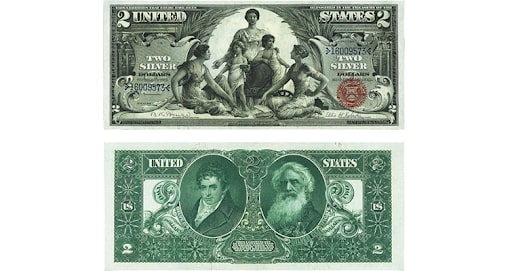
The primary design change for the “small-sized” $2 bill was on the reverse, which featured Jefferson’s home Monticello (1928 and 1953) and a modified image of John Trumball’s 1818 painting of the presentation of a draft of the Declaration of Independence to the Continental Congress.
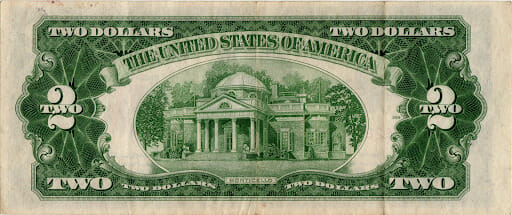
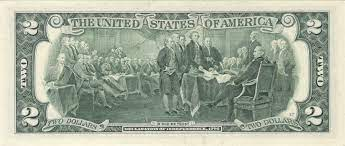
2 Dollar Bill Value, Rarity, and Collectibility
How much is a 2 dollar bill worth
Basically, a modern $2 bill (1976 and newer), especially when in circulated condition with folds, etc., is worth $2. Even the most uncirculated examples are $2 items, largely because so many have been saved, and relatively few have been placed into circulation.
One exception is a “Star Note,” especially in uncirculated conditions. “Star Notes” are issued with the serial number and a star indicating that they are replacements for $2 bills badly damaged in the printing process and thus not released for circulation.
Some serial numbers or signature combinations may also have some collector value.
How many 2 dollar bills are in circulation today?
According to the Federal Reserve, 1.4 billion $2 bills were in circulation in 2020.
What makes specific 2 dollar bills more valuable than others?
- Any of the large-sized $2 bills (issued from 1862 until 1928) will have collector value depending upon their condition/their third-party grade. None of these will be found in circulation today.
- The small-sized $2 bills 1953 and before–especially in uncirculated condition–will have some collector value beyond $2.
- “Star Note” $2 bills (issued in replacement of $2 bills damaged during the printing process) in uncirculated condition will bring some extra value from collectors.
- Some serial number combinations (serial numbers under 100; serial numbers all of one numeral; “radar notes”–where the serial number reads the same forward and backward, e. G. 45677654– and other unusual serial number combinations may be sought after by collectors.
Most Valuable 2 Dollar Bills
What are the rarest and most valuable 2 dollar bills in existence?
The 1890 Large-sized $2 (either red seal or brown seal) can have substantial value depending upon its condition. Heritage Auctions sold an 1890 $2 bill in “fine” condition (well-worn/folded, etc.) for $661.25 in 1/13. In the same auction, a PCGS-graded Gem New 66 PPQ 1890 $2 bill sold for $52,875.00.
A $2 bill’s condition, known rarity, collector/investor demand, etc., have and will probably continue to determine the “rarest and most valuable” $2 bills in existence.
How much are these bills worth, and where can they be found?
Pretty much any especially valuable $2 bill will
(a) need to be third-party graded by PMG (Paper Money Guarantee) or PCGS Banknote Grading;
(b) could be found at major currency auctions (some of the major currency auction firms are Heritage, StacksBowers, Great Collections, Lyn Knight Auctions, etc.) or from specialized currency dealers.
A $2 bill’s condition, known rarity, collector/investor demand, etc., have and will probably continue to determine “how much these bills are worth.”
What makes these bills so valuable to collectors and investors?
The same sort of things that make a Van Gogh painting or a 1952 Topps Mickey Mantle Rookie baseball card valuable to collectors and investors makes some $2 bills valuable to them–condition, limited number available, popular demand, belief in future price appreciation, etc.
The Use and Acceptance of the 2 Dollar Bill
Do businesses and individuals still use the 2 dollar bill in transactions?
To some extent, yes. The relative unfamiliarity of the $2 bills available in circulation can be a hindrance–some who are unfamiliar with the $2 bill have at least initially rejected it as a counterfeit, while some individuals have increased their circulation for symbolic reasons (Clemson University fans have tended to use $2 bills, as have horse race gamblers, some who tip for services rendered, etc.)
Why are some people hesitant to accept or use the 2 dollar bill?
Typically because those individuals are not familiar with $2 bills and sometimes fear that $2 bills are either counterfeits or “play money.”
How can one encourage the use of 2 dollar bills in daily transactions?
A number of individuals go out of their way to always carry some $2 bills with them and to use them in purchases and other transactions, with “educational explanation” provided as necessary. The more people who do this, the likelier that understanding of and circulation of $2 bills will result.
The Legends and Myths Surrounding the 2 Dollar Bill
What are some of the interesting stories and legends associated with the 2 dollar bill?
In 2005, a man in Baltimore, Maryland, was jailed for attempting to use $2 bills that the store and local police incorrectly thought were counterfeit because of smeared ink on some of the bills.
In 2016, a 13-year-old girl in Texas was detained by police for attempting to use a $2 bill to pay for lunch in her school’s cafeteria. The bill, a series 1953 red seal, while still legal tender, was old enough that the school’s counterfeit pen would not work on it, as the chemical properties of the paper used for United States currency prior to 1960 are such that a counterfeit pen is unable to prove whether or not the bill is genuine….”
Other “urban legends” regarding $2 bills allege that they were often used to bribe politicians or to pay prostitutes, as well as to place horse racing bets.
Superstitions or beliefs surrounding the 2 dollar bill?
The corners of some $2 bills, including the numeral 2, were often torn off due to the word “deuce” having been a euphemistic reference to the Devil from the Seventeenth Century onward, i.e. “What the Deuce are you doing?”
To avoid any connection with the Devil and to provide protection from him, some people tore “the deuce” off of their $2 bills. Even at that, $2 bills were often viewed as bringing bad luck to their possessors.
What are the most common misconceptions about the 2 dollar bill?
- That it is a counterfeit;
- That it isn’t “real money”–it’s “play money;”
- That the U. S. Government is making no more $2 bills.
1976 2 Dollar Bill
1976 2 Dollar Bill Specificities
The 1976 small-sized $2 bill departed from Jefferson’s Monticello on its reverse and used a modified version of John Trumball’s 1818 painting showing the presentation of a “draft” of the Declaration of Independence to the Continental Congress. Although not created specifically to commemorate the U. S. Bicentennial, the timing of the release of the 1976 $2 bill did increase public interest in it.
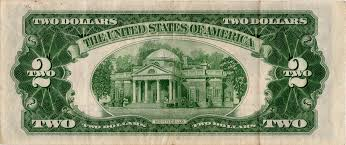
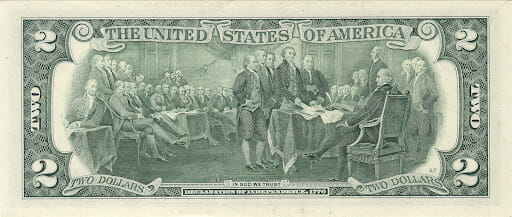
1976 2 Dollar Bill Value
In most instances, a 1976 $2 bill is worth $2, since 590,720,000 were issued. Small exceptions involving unusual serial number combinations, such as $2 bills displaying only one numeral, serial numbers under 100, etc.; 1976 $2 bills stamped and mailed with a Bicentennial postmark; occasionally, to a slight degree, crisp uncirculated 1976 $2 bills; etc. may have slightly greater value.
1953 2 Dollar Bill
1953 2 Dollar Bill Specificities
The 1953 $2 bill was modified slightly from the design of the small-sized 1928 $2 bill. As Wikpedia notes: “… In 1953, the $2 bill, along with the $5 United States Note, received minor design changes. The treasury seal was made smaller and moved to the right side of the bill; it was superimposed over the gray word two. The United States Note obligation now became superimposed over a gray numeral 2. The reverse remained unchanged.[24]….”
1953 2 Dollar Bill Value
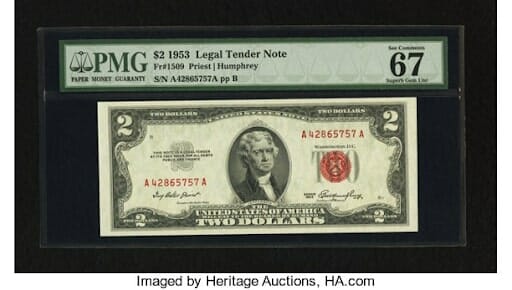
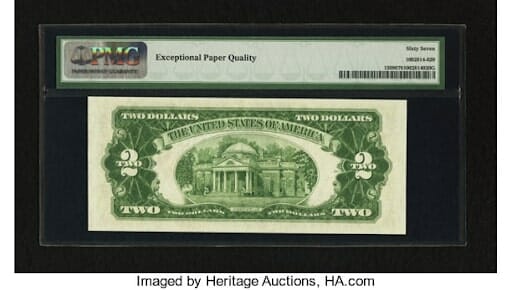
In excess of 79 million 1953 $2 bills were made, along with 3.9 million “star” notes (notes issued with the same serial number plus a star, in replacement of notes so damaged in production as to require replacement). The large number of 1953 $2 bills made is a factor reducing their value, though 70 years of attrition to that number of 1953 $2 bills somewhat counterbalances its initial low value.
Circulated 1953 $2 bills have a value of around $2.50 or more, depending upon condition. The gem uncirculated 1953 $2 bill pictured sold for $89 in a Heritage Auction on 10/12.
1928 2 Dollar Bill
1928 2 Dollar Bill Specificities
The 1928 $2 bill was the first “small-sized” $2 bill (6.14 inches by 2.61 inches). It employed a reduced version of Thomas Jefferson’s portrait that had been previously used on $2 bills. An image of Monticello, Jefferson’s home, was placed on the reverse. Similar to other U. S. notes, the treasury seal and serial numbers were printed in red. The treasury seal was superimposed by the United States Note obligation to the left and by a large gray two to the right.
1928 2 Dollar Bill Value
A PMG Gem Uncirculated 66 sold for $8,812.50 in a Heritage Auction on 4/16. This is rather the exception since nearly 450 million 1928 $2 bills were printed, and many survive in circulated condition bringing from $2 to low double figures depending upon their circulated condition.
2013 2 Dollar Bill
2013 2 Dollar Bill Specificities
About 45,000,000 2013 $2 bills were printed for the Federal Reserve Bank of Atlanta.
2013 2 Dollar Bill Value
The 2013 $2 bill was made recently enough, and in large enough quantity, that other than serial-numbered bills featuring only one numeral; serial numbers under 100; etc., they are basically worth $2.
The 2 Dollar Bill in Popular Culture and Entertainment
The 2 dollar bill has appeared in various popular culture and entertainment forms. From its use as a prop in movies and TV shows to its mention in books and music, the 2 dollar bill has captured the attention and imagination of many.
Notably, the 1976 series of 2 dollar bills was featured prominently in the movie “The Sting,” which helped to revive interest in the bill among collectors. Celebrities such as Johnny Carson, Jay Leno, and Martha Stewart have publicly expressed their love for the 2 dollar bill. The unique design and rarity of the bill have also made it a popular subject for advertising and marketing campaigns.
The Future of the 2 Dollar Bill
Will the 2 dollar bill continue to be printed and circulated in the future?
A fair question to ask is to what extent any paper money will continue to be printed and circulated in the future as the U. S. and the world move closer to becoming a cashless society?
It seems likely that the $2 bill has some future yet since it costs half as much to print as the same dollar volume of $1 bills. A possible “Wild Card” is the extent and duration of inflation, which could possibly reduce the purchasing power of a $2 bill such that its purchasing power becomes negligible.
That has happened to (especially) the penny, nickel, and dime over my lifetime. When I was a kid in the 1950s, a penny would buy three sticks of “Chum Gum,” and a dime would buy a bottle of Coca-Cola. Today these coins can buy virtually nothing by themselves. This may or may not happen to other coins and currency (perhaps including the $2 bill) in the future.
What are some potential changes that may affect the future of the 2-dollar bill?
Increased inflation; more widespread use of digital cyber currency; increased (or decreased) use and acceptance of the $2 bill by the American public; etc.
How will the continued popularity of the 2 dollar bill impact the world of numismatics?
Currently, the large-sized $2 bills (1862-1918) attract the greatest interest in numismatics due to their relatively low numbers printed, attrition over a century or more, and scarcity in high-grade uncirculated conditions. Special serial numbers, etc., on small-sized $2 bills also attract collector interest. Nobody has a Crystal Ball, but it seems reasonable that these current trends will continue to impact the world of numismatics into the future.
The Process of Collecting 2 Dollar Bills
What are the basic steps one should take to start a collection of 2 dollar bills?
Narrowing one’s collecting interest based upon budget, personal preferences as to type and grade/condition, and availability of desired $2 bills comes first and likely will vary with each individual, perhaps being modified over time.
Where can one find and purchase 2 dollar bills, both new and old?
New $2 bills are probably readily available at one’s bank. Old/Rare/Desirable $2 bills may be found at reputable (local and national) coin dealers; the Internet (Be careful! Fakes of rare issues sold by Scammers are “out there!”); and major coin auction firms (Great Collections; Heritage; StacksBowers; Legend; etc.)
What are some best practices for storing and displaying a collection of 2 dollar bills?
The major third-party grading firms (PMG; PCGS Banknotes) seal notes submitted to them in non-reactive, firm plastic holders to protect them. Currency albums are also helpful in this regard. Bank-safe deposit boxes kept in a humidity and temperature-controlled environment are helpful, as are silica gel boxes kept in one’s home safe.
The Symbolism and Meaning of the 2 Dollar Bill
What does the 2 dollar bill symbolize or represent to different people and cultures?
“In some cultures and belief systems, the number 2 is associated with balance and duality, which can be interpreted as having spiritual significance….The number 2 has been associated with duality or balance in various spiritual traditions. In Chinese philosophy, the concept of yin and yang represents the complementary forces of the universe, and the number 2 is often used to symbolize this balance.
Similarly, in Hinduism, the dualistic concept of Purusha and Prakriti represents the spirit and matter, respectively, and the number 2 can represent their interplay.
In numerology, the number 2 is associated with cooperation, diplomacy, and harmony. It is considered a feminine number and is associated with the moon, which represents emotions and intuition…. In some cultures, it is customary to give two-dollar bills as a gift to couples on their wedding day, as a symbol of their partnership and commitment….”–Susan Bynes, “The $2 Bill: Exploring its Spiritual Meaning,” March 23, 2023, Totallythedream.com
How has the meaning of the 2 dollar bill evolved over time?
“Fun Facts about the Two-Dollar Bill
- Nicknamed the “Tom” because they feature Thomas Jefferson’s portrait on the face
- Has been linked in the past to bribery, election rigging, gambling, prostitution, and bad luck in general
- Used by Clemson University, Geneva Steel, and 2nd Amendment proponents….”–by Mary Piles, CNB St. Louis Bank HistorianPosted: February 22, 2022, cnbstl.com
What are some of the deeper messages or themes conveyed through the 2 dollar bill?
“In some cultures and belief systems, the number 2 is associated with balance and duality, which can be interpreted as having spiritual significance….The number 2 has been associated with duality or balance in various spiritual traditions. In Chinese philosophy, the concept of yin and yang represents the complementary forces of the universe, and the number 2 is often used to symbolize this balance.
Similarly, in Hinduism, the dualistic concept of Purusha and Prakriti represents the spirit and matter, respectively, and the number 2 can represent their interplay.
Conclusion
The $2 Bill (1862-Present) is not frequently seen in commercial transactions, leading to frequent misunderstandings as to its rarity and value.
Since 1862, well over two billion $2 bills have been printed. As a result, most are worth $2, with exceptions for the large-sized $2 bills printed from 1862-1918 and for “modern” small-sized $2 bills displaying unusual serial number combinations; “star notes” issued in replacement for damaged $2 bills; (infrequently) for crisp uncirculated $2 bills (primarily from early series and/or containing scarce Treasurer/Secretary of the Treasury signature combinations); etc.
They are generally affordable collectibles, especially in small-sized examples. The association that many $2 bills have with U. S. History, portraying Thomas Jefferson, Monticello, or the presentation of a draft of the Declaration of Independence to the Continental Congress, makes them interesting and educational.
Sources & References
- Bynes, Susan. “The $2 Bill: Exploring its Spiritual Meaning,” March 23, 2023, Totallythedream.com
- Piles, Mary, CNB St. Louis Bank Historian. February 22.2022, “The Infamous Two Dollar Bill,” www.cnbstl.com

